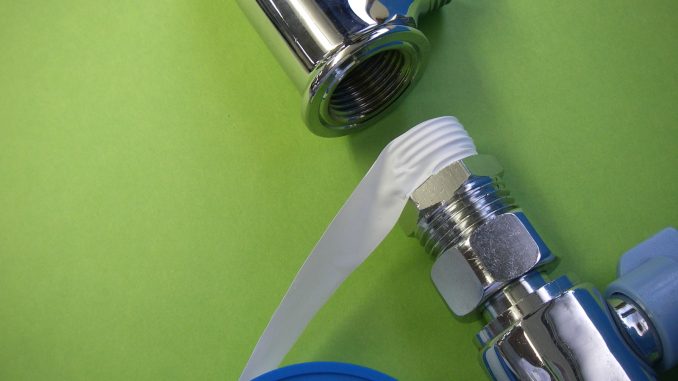
Plumber’s tape is a simple product which helps to create watertight seals on threaded pipe joints – provided you know how to use it.
That might sound ominous but plumber’s tape is easy-to-use. In fact, the biggest issue you will probably have is what to call it, as it also goes by the name of PTFE tape, Teflon tape or thread seal tape.
All those titles refer to the same product, which is wrapped around threads to provide a watertight seal when a pipe is connected to a fitting. Knowing the correct direction to wrap the tape is crucial to a successful application, which we will explain in just a bit.
As well as thread sealing, PTFE tape also helps to lubricate the connection which makes threading easier and it will prevent pipes from sticking. That allows for easier disassembly of the system at a later date.
Watertight seals and the prevention of pipe joints seizing up – it is little wonder that plumber’s tape, PTFE tape, Teflon tape, thread seal tape, whatever you want to call it tape, is such a popular product – and here is how to use it.
Clean the threads to be sealed
To ensure a successful application of plumber’s tape, you should start by cleaning the threads which you will apply the tape to – even if they are brand new.
Freshly cut threads may not have been cleaned properly after being machined, leaving them with metal shavings or oils from the manufacturing process which will reduce the effectiveness of the tape. For older pipes then dirt, grease, rust and grime may have built up on the threads.
Allow the threads to dry
If you have used a cleaning liquid to prepare the threads or the pipework in question is wet, then you should allow it time to dry before applying PTFE tape.
Plumber’s tape works best when applied to a dry surface, so do your best to remove any moisture from the threads that will be mated together for a more successful seal.
Wrap the plumber’s tape in the correct direction
As already mentioned, the key to knowing how to use plumber’s tape is to wrap the tape in the correct direction. This is from the threads at the end of the pipe up the pipe and in the opposite direction to which the pipe will be turned.
Applying thread sealing tape this way ensures that when the pipe is turned into the fitting, the friction will tighten the tape around the pipe to create a watertight and successful connection.
If you wrap the tape in the opposite direction, then it can bunch or unravel when the pipe is turned into the fitting, which is how unsuccessful applications happen.
How many overlaps of plumber’s tape are needed for successful use?
You should overlap the layers of plumber’s tape by about half their width, wrapping until you reach the end of the threads.
The tape should be pulled tight as you wrap to ensure that it fits snugly around the pipe, allowing you to see the threads’ ridges through it.
Continue for one full wrap past the bottom of the final thread before breaking the tape. Smooth the loose end down and you will have a pipe that is ready to provide a watertight seal to a fitting.
Applications in which plumber’s tape can be used
Plumber’s tape can be used with any threaded connections, on all types of metal pipes and some plastic PVC pipes.
In domestic settings, plumber’s tape is commonly used to provide watertight seals on shower heads and shower arms, in pipe-to-coupling connections and pipe-to-valve connections.
For applications involving gas pipes, a specialist PTFE tape exists which is thicker and denser than standard plumber’s tape.
It is not advisable to use normal plumber’s tape in conjunction with gas as it will degrade far too quickly, potentially leading to gas leaks.
A specialist plumber’s tape exists for gas pipes which is thicker and denser. When working with anything other than water pipes, it is always best to consult a stockist for PTFE tape designed for use with gas.
Repairing a leaking pipe
While plumber’s tape is the perfect solution for helping to seal threads, it does not provide an adequate long-term repair for a cracked or leaking pipe.
If you are looking to fix a damaged pipe, you should instead use a pipe repair tape. Pipe repair tapes are made from self-fusing silicone and stretch by up to 300% their length.
When wrapped around a hole or leak, it will fuse into a solid rubber band over the damaged area to provide a repair that is capable of withstanding pressure up to 30bar.

Leave a Reply